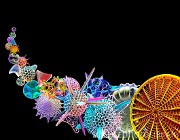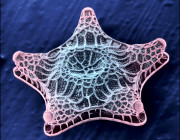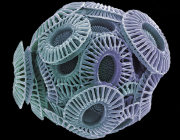Home :: List of Publicly Available Datasets :: Karenia brevis Wilson
Karenia brevis Wilson
Downloads:
| Principle Investigator(s) | Lisa Campbell |
|---|---|
| External sample ID | Wilson_35 |
| NCGR Sample ID | MMETSP0648_2 |
| Sample accession number | CAM_SMPL_002706 |
| Assembly accession number | CAM_ASM_000524 |
| Combined Assembly Name | Karenia-brevis-Wilson |
| Genus | Karenia |
| Species | brevis |
| Strain | Wilson |
| Clonal | Yes |
| Axenic | No |
| Prelim. NCBI Taxon ID | 156230 |
| 18S rRNA | |
| Importance of organism and transcriptomes | Karenia brevis is a planktonic dinoflagellate that produces harmful algal blooms almost every year in the Gulf of Mexico. Most strains of K. brevis produce a suite of toxic compounds including brevetoxins (2 main backbone types, PbTx-1 and -2) that are potent neurotoxins. The dominant life history stage of dinoflagellates is haploid, and the sexual stages and resting cysts (if any) are not well known for K. brevis. Most clonal cultures of K. brevis produce ~10-20 pg brevetoxin per cell and this is mostly PbTx-2 (90% of total toxin). The SP1 clone produces extremely low levels of brevetoxin (or, none). The toxin synthesis pathway and the function of brevetoxin in K. brevis is not known, therefore transcriptome data for SP1 clone in comparison with data from other clones (such as SP3, which produces mostly PbTx-1 and Wilson, which produces consistly high levels) will be informative. The comparative approach is valuable as no experimental genetic system (e.g. knock-out mutants) is available. Karenia brevis is a planktonic dinoflagellate that produces harmful algal blooms almost every year in the Gulf of Mexico. Most strains of K. brevis produce a suite of toxic compounds including brevetoxins (2 main backbone types, PbTx-1 and -2) that are potent neurotoxins. The dominant life history stage of dinoflagellates is haploid, and the sexual stages and resting cysts (if any) are not well known for K. brevis. Most clonal cultures of K. brevis produce ~10-20 pg brevetoxin per cell and this is mostly PbTx-2 (90% of total toxin). The SP1 clone produces extremely low levels of brevetoxin (or, none). The toxin synthesis pathway and the function of brevetoxin in K. brevis is not known, therefore transcriptome data for SP1 clone in comparison with data from other clones (such as SP3, which produces mostly PbTx-1 and Wilson, which produces consistly high levels) will be informative. The comparative approach is valuable as no experimental genetic system (e.g. knock-out mutants) is available. |
| Additional citations and references | Errera, R. M., Bourdelais, A., Drennan, M. A., Dodd, E. B., Henrichs, D. W. & Campbell, L. 2010. Variation in brevetoxin and brevenal content among clonal cultures of Karenia brevis may influence bloom toxicity. Toxicon 55:195-203; Daugbjerg, N. G. Hansen, J. Larsen, and O. Moestrup. 2000. Phylogeny of some of the major genera of dinoflagellates based on ultrstructure and partial LSU rDNA sequence data, including the erection of three new general of unarmoured dinoflagellates. Phycologia 39(4): 302-317. |
| Environmental Data | |
| Primary citation for organism's characterization, if available | Henrichs, D. W., Renshaw, M. A., Santamaria, C. A., Richardson, B., Gold, J. R. & Campbell, L. 2008. PCR amplification of microsatellites from single cells of Karenia brevis preserved in Lugol's iodine solution. Marine Biotechnology 10:122-27. |
| Collection date | 01-OCT-99 |
| Sample collection site | Gulf of Mexico |
| Other collection site info | South Padre Island |
| Sample material (e.g. "seawater," "sediment," etc.) | seawater |
| ENVO term for habitat - primary term | Acquatic: marine |
| Habitat description | coastal harmful algal bloom |
| Other environmental metadata available | Haplotype based on 18 microsatellite loci at http://oceanz.tamu.edu/~campbell/gmx_msat/ |
| Other environmental metadata available | Haplotype based on 18 microsatellite loci at http://oceanz.tamu.edu/~campbell/gmx_msat/ |
| Habitat | marine habitat |
| Country | UNITED STATES |
| Experimental Data | |
| Date of experiment | 27-MAY-11 |
| Growth medium | L1 amended seawater |
| Modifications to growth medium | NA |
| Temperature (ºC) | 25 |
| Salinty (psu) | 35 |
| pH | 8.3 |
| Light (µmol photons / m2 / sec) | 70 |
| Day portion of day:night cycle in hours | 12 |
| Night portion of day:night cycle in hours | 12 |
| Nitrate (μmol/L) | 882 |
| Phosphate (μmol/L) | 36.2 |
| Trace elements (total) (nmol/L) | 25 |
| Prey organism, if applicable (genus and species) | NA |
| Investigation type | Eukaryotes |
| Other experimental metadata available | acclimated to salinity of 35 |








